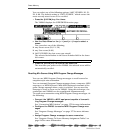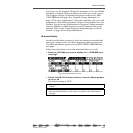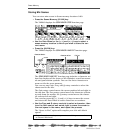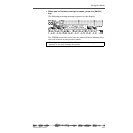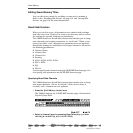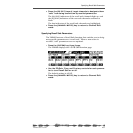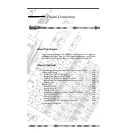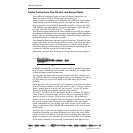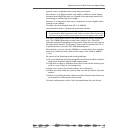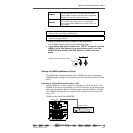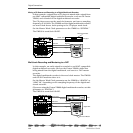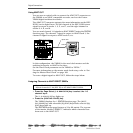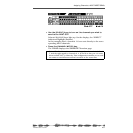
Digital Connections
160
VM200 User’s Guide
Digital Connections, Word Clocks, and Sample Rates
The VM200 is equipped with two types of digital connectors: an
ADAT interface and S/P DIF In and Out connectors.
These connectors enable you to interface the VM200 to other digital
components in your recording studio. You can use the ADAT inter-
face to connect to any ADAT-compatible recorder, such as the FOS-
TEX VR800 or an Alesis ADAT. For more information “ADAT IN/OUT”
on page 165 and “S/P DIF IN/OUT” on page 168.
This section reviews some basic issues involved in setting up a digital
recording environment. (If you’ve worked with digital audio equipment
before, you are probably already familiar with word clock synchroni-
zation issues and can skip this section.)
The following illustration shows a typical waveform. Technically, this
graph represents
force
along the vertical axis (i.e., the force an audio
speaker requires to move a certain amount of air to create sound),
and
time
along the horizontal axis. The waveform is an analogy for the
soundwave position at specific points in time.
(Musically, however, this waveform could represent your next big hit :-)
A digital-to-analog (D/A) audio converter takes numerous tiny sam-
ples of such a waveform each second, and converts the sample data
to digital binary digital information.
The number of samples taken each second is called the “sample rate.”
The VM200, like many current digital devices, can sample at a rate of
44,100 times per second (44.1kHz) or 48,000 times per second
(48kHz).
Each time the converter samples the waveform, it records waveform
data as a binary number in a format called a “word.” A bit is a unit of
data, a single digit in a word, the “one-or-zero,” “on-or-off” funda-
mental encoding of the digital universe. For instance,
1011011110111001 is a 16-bit binary word. It contains 16 digits or
“bits” of data. If you are using 16-bit words, your system is said to
have a bit-rate of 16 bits. (This is also called the “bit resolution.”)
A word clock is a clock signal that you can use to synchronize all the
devices in a digital audio system. If the VM200 is the only digital
audio component in your studio, you don’t need to worry about set-
ting the word clock. (The VM200 will synchronize to its own internal
word clock.)
However, if you use a second digital device, such as a DAT or digital
multitrack recorder, you must designate one device the word clock
master
and the rest
slaves
. You may need to change word clock set-
tings on occasion, such as when you record from a DAT or CD player.
If the word clocks are not correctly synchronized throughout your
force
time



